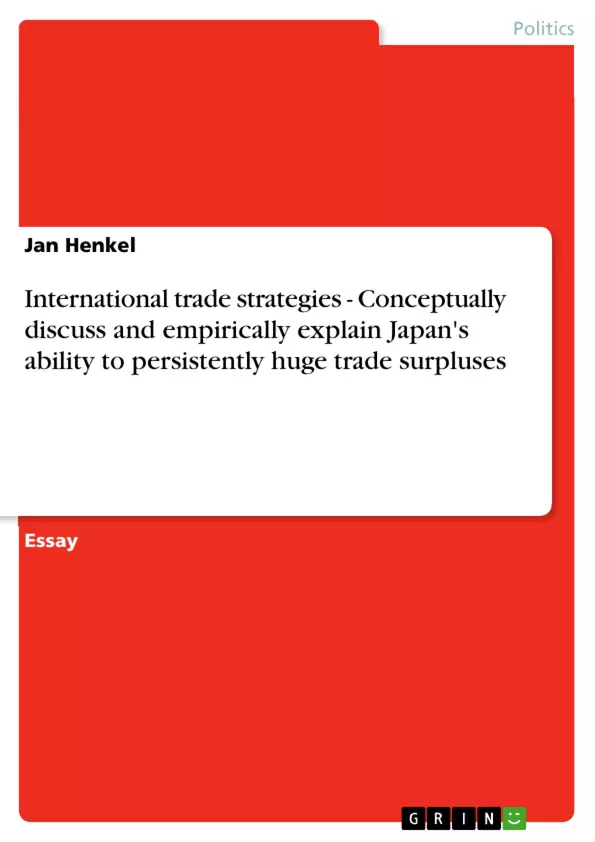In the early 1950s “export or die” was a national slogan, which describes one strategy of the govenment to ensure economic growth in Japan.
This essay is dealing about international trade strategies in Japan after the second World War. The major goal of this work is to conceptually discuss and emprically explain how it was possible for Japan to sustain huge trade surpluses.
First of all it is necessary to define what is meant by trade surplus. A trade surplus exists when the balance-of-trade of a country is positive. That means that the extent of the value of merchandise exports has to exceed the value of merchandise imports (Levi: p. 589).
In general a country can achieve a trade surplus if it tries to maximize its exports and to minimize its imports.
The structure of my essay is followed by these two principles. Therefore a first part will deal with the exports of Japan, i.e. with the question how exports can be maximized. I will try to dicuss how exports have been promoted by MITI and what further circumstances led to the significant growth of the export sector.
In a second part I am going to analyse the restrictions on imports. This chapter will include the explanation of tariff and non- tariff barriers as well as a discussion about the closed nature of the Japanese market.
But previous it is necessary to deal with the theoretical concepts. After that I am going to compare these with what happened in the Japanese reality so that I can finally summarize which factors have been the most influential to maintain the surplus of Japanese balance- of- trade.
Inhaltsverzeichnis (Table of Contents)
- Introduction
- Main part
- Theoretical explanations
- Export promotion and import restrictions
Zielsetzung und Themenschwerpunkte (Objectives and Key Themes)
This essay explores the international trade strategies employed by Japan following World War II, specifically examining the factors contributing to the country's persistent trade surpluses. The primary objective is to analyze both the conceptual framework and empirical evidence behind Japan's ability to sustain these surpluses.
- The "export or die" strategy and its role in export-led growth.
- The "developmental state perspective" emphasizing the involvement of the government, particularly MITI, in shaping the Japanese economy.
- The impact of import restrictions, including tariff and non-tariff barriers, on the Japanese market.
- The influence of various theoretical perspectives, including the "creative defeat perspective," the "free-market perspective," and the "neo-marxist theory."
- The role of total factor productivity (TFP) in contributing to Japan's economic efficiency.
Zusammenfassung der Kapitel (Chapter Summaries)
- Introduction: The essay introduces the concept of trade surplus and the "export or die" strategy, highlighting Japan's post-war economic policy. It outlines the structure of the essay, focusing on the promotion of exports and the restrictions on imports.
- Theoretical Explanations: This chapter explores various theories explaining Japan's economic growth and trade surpluses, including export-led growth, the developmental state perspective, the creative defeat perspective, the free-market perspective, the neo-marxist theory, and the total factor productivity (TFP) approach.
- Export Promotion and Import Restrictions: This chapter delves into the strategies employed by the Japanese government, particularly MITI, to promote exports and restrict imports. It discusses the targeting of strategic industries, the importance of sunrise industries, and the role of joint ventures with foreign firms.
Schlüsselwörter (Keywords)
This essay focuses on the key concepts of international trade strategies, trade surpluses, export-led growth, the "developmental state perspective," MITI, import restrictions, tariff and non-tariff barriers, the Japanese market, sunrise industries, and total factor productivity (TFP).
- Arbeit zitieren
- Diplom Volkswirt; M.A. Jan Henkel (Autor:in), 2004, International trade strategies - Conceptually discuss and empirically explain Japan's ability to persistently huge trade surpluses, München, GRIN Verlag, https://www.hausarbeiten.de/document/54930


